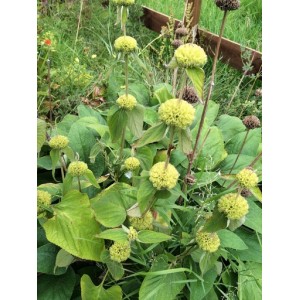Phlomis Russeliana is an attractive, unusual looking long-flowering perennial. Sometimes known as Phlomis viscosa, because of its sticky leaves. It has beautiful Green leaves and Yellow flowers.
Soil Preparation
Phlomis plants, also known as Jerusalem sage, prefer well-drained, fertile soil with a slightly alkaline pH range of 7.0 to 8.0. Choose a planting site that receives full sun for at least six hours per day. Before planting, enrich the soil by incorporating organic matter, such as compost or aged manure, to improve drainage, fertility, and water retention.
Sowing Seeds
Phlomis seeds are best sown directly outdoors in early spring after the last frost has passed. In most climates, this is typically in late April or early May. However, it is important to check the appropriate sowing time for your specific region. To sow the seeds, scatter them thinly over the prepared soil and cover them with a light dusting of soil. Keep the soil moist but not soggy. Water the seeds regularly to ensure they have enough moisture to germinate.
Germination and Early Care
Phlomis seeds have a relatively long germination period, taking anywhere from 4 to 6 weeks to sprout. Once the seedlings have emerged, they will need to be thinned to prevent overcrowding. Space the seedlings 18 to 24 inches apart.
Transplanting Seedlings
Once the seedlings have developed two sets of true leaves, they are ready to be transplanted outdoors. Harden off the seedlings by gradually exposing them to outdoor conditions over a period of 7 to 10 days. This will help them acclimate to the outdoor environment and reduce transplant shock. Choose a suitable planting site that receives full sun and has well-drained soil. Space the seedlings 18 to 24 inches apart to prevent overcrowding.
Watering and Fertilizing
Phlomis plants are drought tolerant once established, but they will need regular watering during the first year of growth. Water the plants deeply and infrequently, allowing the soil to dry slightly between waterings. To encourage healthy growth and abundant blooms, fertilize the plants every few weeks with a balanced liquid fertilizer.
Deadheading and Mulching
Deadheading spent flowers is important to encourage continuous blooming and prevent seed formation, which can divert energy from flower production.
Mulching around the plants with organic matter, such as shredded leaves or bark, helps retain moisture, suppress weeds, and regulate soil temperature.
Additional Tips
Phlomis plants may require staking to support their weight and prevent them from toppling over, especially as they mature and produce their signature flower spikes.
Phlomis plants are relatively resistant to pests and diseases, but keep an eye out for common garden pests like slugs and snails.
Phlomis plants can be left standing in the garden for winter interest, as their seed heads provide ornamental value. However, if you prefer to remove them, do so after they have completely dried out.
By following these guidelines and providing proper care, you can cultivate a stunning display of Phlomis plants that will add a touch of architectural interest and dramatic foliage to your garden for years to come.
Enjoy your beautiful Phlomis flowers!
PHLOMIS RUSSELIANA SEEDS - TURKISH SAGE - 25 SEEDS
- Product Code: 25 PHLOMIS RUSSELIANA SEEDS - TURKISH SAGE SEEDS
- Availability: In Stock
-
£3.99
-
- 2 or more £3.79
- 3 or more £3.49
- 5 or more £3.29
- 10 or more £2.99

